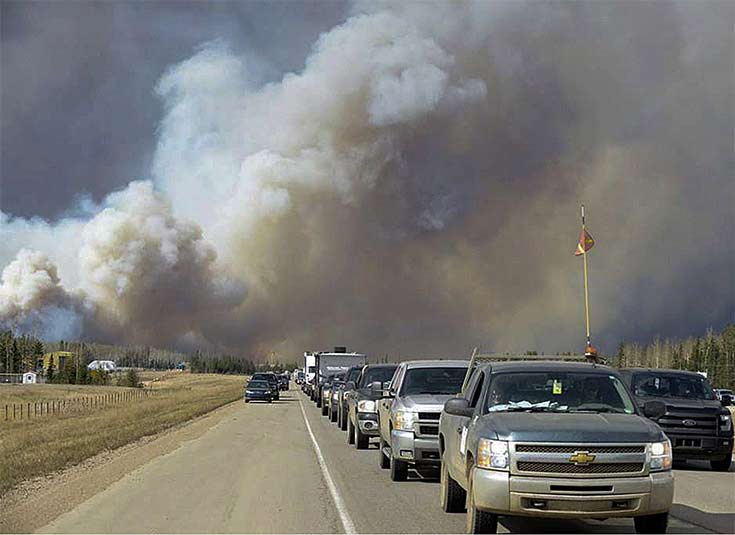Experts urge better decisions on who and when to warn in emergencies
Well designed and executed emergency warnings can save lives, so risk experts are urging steps to create the most effective warnings for hurricanes, wildfires, and other environmental hazards. The group of experts is proposing a new framework and research agenda that they believe will support the most effective public warnings when a hazard threatens safety. Effective warnings are a growing need as expanding global populations confront a wide range of hazards.

Fort McMurray, May 2016: Raging forest fires, whipped up by shifting winds, sliced through Fort McMurray in Canada, sending tens of thousands of people fleeing and prompting the evacuation of the entire city. In light of the many global environmental hazards, experts are developing new procedures to simplify the warning process, aiming to prevent casualties and increase transparency about the decision-making process (Canadian Press / Rex)
“The potential for errors is high,” when officials decide when to issue emergency warnings, who to send them to, and what safety measures to urge the public to take, says Thomas Cova, a professor in the University of Utah geography department.
This is because: “Researchers tend to focus on one or two of those questions,” according to Cova. “But it's a challenge to think about all three,” which is necessary to avoid such errors as deciding the right time and right action – but wrong target group – or the right group and right time, but wrong protective action.
Emergency managers must contend with uncertainty about how the three components interact, and have to consider how likely and how costly it might be to make ‘false positive’ decisions to issue a warning when hazards do not occur, or ‘false negative’ decisions to continue normally when hazards do take place.
Cova and colleagues have published a paper called Warning triggers in environmental hazards: Who should be warned to do what and when? This proposes a way forward in improving emergency warning by thinking constructively and critically about all three issues.
Currently, public warning researchers are each carving out little hazard niches (hurricanes, wildfires, hazmat), as well as single dimensions of the warning problem (timing them, delimiting risk zones, selecting protective actions). “The end result is that no-one is taking on the big question of simultaneously asking: who should do what, when?” Cova explains.
The authors’ goal is to sound a wake up call that they hope will lead to an improved understanding of how warnings are formulated and implemented across hazards which, in turn, could lead to improved training methods, warning system innovations and synergy between researchers and emergency managers.
“We're not proposing a new approach to warnings, we're proposing a new approach to public warning research,” Cova says, but adds: “The results may have beneficial feedback into public warning improvements and innovations.”
Today’s guidance on emergency warnings is not optimal. In light of the many global environmental hazards, experts are developing new procedures to simplify the warning process, aiming to prevent casualties and increase transparency about the decision-making process. Widely used warning triggers are a decision rule that links an environmental condition to ‘protective action recommendations’ for a specified target group.
For example, fire occurrence is a common qualitative trigger condition, but a more specific indicator would be a flame front crossing a prominent ridgeline, river, or road towards a community. Rainfall rates and duration can serve to define a threshold value that, once exceeded, results in a warning for flooding or landslides. These triggers aid managers in deciding when to change from ‘wait and see’ to ‘take immediate action’, thereby helping them stay ahead of the emergency’s advancing curve.
But even though warning triggers are often used, little research has been carried out into how emergency managers set them, or into their effectiveness when combined with integrated early warning systems, the authors write. In an overview of key warning trigger issues, the authors discuss the critical importance of an ‘unambiguous trigger condition’ when deciding when to issue a warning, as well as methods for defining the condition, such as directly observed environmental cues or measurements from sensors.
They also discuss issues pertaining to deciding which population to warn, including the use of emergency planning zones, a physical feature or a built feature that includes apartment buildings and stores. They review the challenges of deciding on the most effective actions to recommend, such as evacuating or sheltering in place.
The problem of effective warnings has: “Dimensions that are geographic, temporal, cognitive, and perceptual, particularly in how the public might respond,” says Cova. “So it's an ideal challenge for interdisciplinary research,” that addresses all three of the key systems at work (natural, built, social) and their interactions across different types of hazards. Emergency managers simultaneously deal with who, what, and when issues every day, and therefore so should research to improve warnings, the authors suggest.
The paper, published in the online version of Risk Analysis, a publication of the Society for Risk Analysis, was co-authored by Cova with colleagues Philip E Dennison, Dapeng Li, and Frank Drews, also of University of Utah, as well as Laura K Siebeneck of University of North Texas and Michael K Lindell of University of Washington.
Risk Analysis: An International Journal is published by the nonprofit Society for Risk Analysis (SRA), an interdisciplinary, scholarly, international society that provides an open forum for all who are interested in risk analysis, a critical function in complex modern societies. The complete study is available here